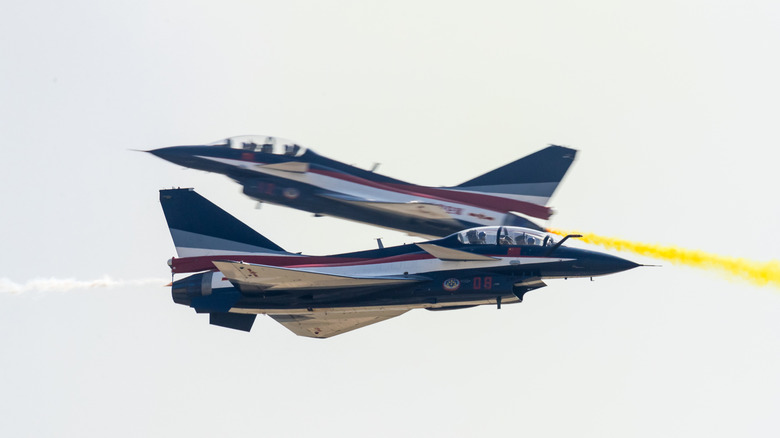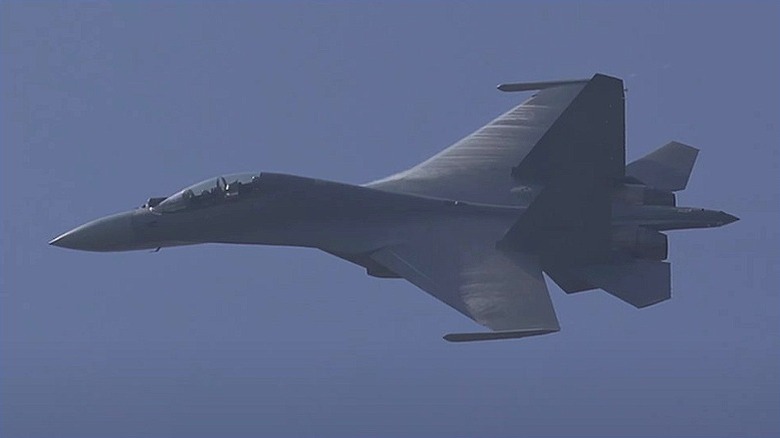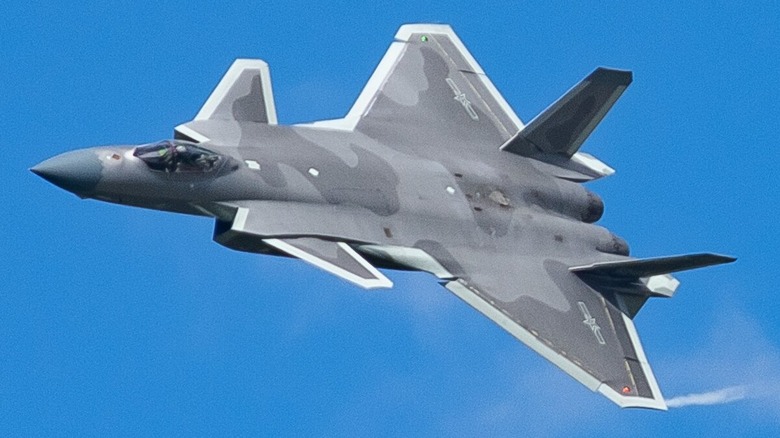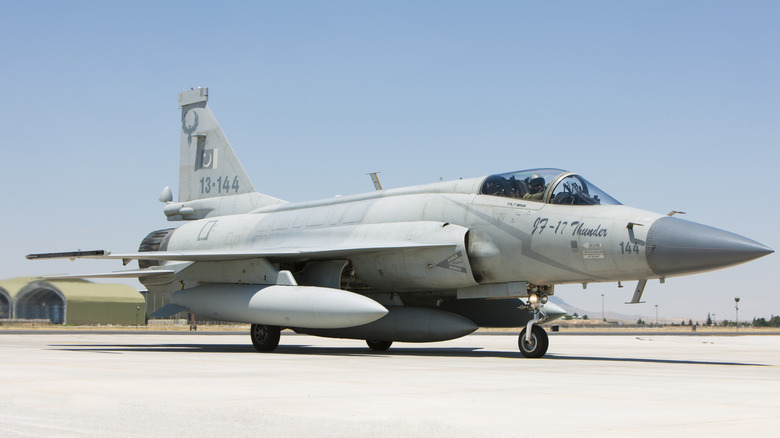5 Of The Most Advanced Chinese Fighter Jets (That We Know Of)
China has proven through its modern fighter jet design that it is ready to take on its Western counterparts in dogfight scenarios. The J-10 defeated French Rafales in the Pak-India combat of May 2025. The two major fighter jet manufacturers in China, the Shenyang Aircraft Corporation (SAC) and the Chengdu Aircraft Corporation (CAC), are leading the market with continuous innovation in next-gen fighters. For instance, the country is working on developing its own sixth-generation jets, China's new Chengdu J-36 and the Shenyang J-50, both of which are the subject of speculation among aviation enthusiasts.
Elaborating on the most advanced Chinese fighter jets that have dominated the skies so far, several attributes combined make them a powerful addition to any air force. To name the most critical aspects, it would be powerful mechanics, careful design, precise maneuverability, and, of course, on-spot targeting systems.
Shenyang J-35
Designed to compete with its Western counterpart, the F-35, the Chinese J-35 features several impressive key points, each of which aids in its remarkable performance against the enemy. It is a fifth-gen carrier-based fighter with a sleek design to help cruise through the air at a staggering top speed of Mach 2 (1535 mph), aided by its twin-engine design. It has a maximum takeoff weight of about 28 tons and can cover a combat radius of approximately 750 miles.
This advanced fighter is applicable for air superiority as well as ground attacks and features an AESA radar system, along with electro-optical targeting systems. The much-awaited J-35A is expected to have the PL-10 short-range missile and PL-15 beyond-visual-range air-to-air missile systems on top of three internal weapon bays and four external hardpoints for loading additional gear.
Apart from this, there's a twin diverterless supersonic intake for reduced infrared radar reflections and enhanced aerodynamic efficiency in the air. The larger dorsal fuselage hump allows for more fuel capacity, giving the fighter some additional flying range. With a wide-angle holographic heads-up display and advanced infrared sensors, the pilot can track all movements.
Shenyang J-16
Being a brainchild of the SAC, the J-16 stealth fighter is a twin-engine and twin-seat aircraft that is capable of rigorous air-to-air combat. These fighters entered the People's Liberation Army in 2015 and can carry different missile systems, such as the PL-10, PL-12, PL-15, and PL-17, for a range of air combat situations.
The J-16 can reach a maximum speed of Mach 2.4 (1,841 mph) and a climb rate of 325 m/s. Its maximum range is up to 3,000 kilometers. The modern cockpit design and a superior radar system help in marking targets, plus there are specialized variants for Suppression of Enemy Air Defenses (SEAD) and Electronic Warfare (EW). Powered by WS-10B turbofan engines, the fighter can generate high thrust. All these features make it a multi-role aircraft that can handle air superiority, ground strike, and suppression of enemy air defense, as well as electronic warfare.
The most recent country seeking the J-16 aircraft is Iran, as it is looking to expand its air force capabilities following the war with Israel. The J-16D variant is an electronic warfare fighter possessing superior jamming abilities, thanks to the integration of an advanced active electronically scanned array (AESA) radar system.
Chengdu J-20
The J-20 manufactured by the CAC is a single-seat twinjet that can deliver exceptional performance in the air regardless of weather conditions. A fifth-generation fighter, the J-20 showcases impressive air superiority and a precise striking system. Like the others in the family, it also features the AESA radar and a 360-degree infrared targeting system with powerful resistance to jamming to engage in contested air battles.
Moreover, the modern aircraft is compatible with a range of air-to-air missile systems, such as the PL-9, PL-10, PL-12C/D, and PL-15–PL-21 — basically covering short and long-range targets. Additionally, there are four hardpoints on the wings to load more weapons. Surprisingly, the J-20 surpasses the famous F-22 and F-35 in terms of speed. Nationalsecurityjournal.org reported some configurations of the J-20 capable of speeds as high as Mach 2.8 (2,000+ mph). The F-22 Raptor is also in the Mach 2 class, reaching Mach 2.2 (1688 mph). The F-35 Lightning reaches Mach 1.6 (1228 mph). The "Mighty Dragon" is a goldmine for gathering intelligence against enemies and engaging in electronic warfare.
Overall, the J-20 is equipped with advanced communication systems and real-time data sharing features to plan coordinated attacks, particularly the twin-seat J-20S variant. With a huge combat range of 2,000 km (1243 miles), paired with aerial refueling ability, the fighter has excellent stealth that can serve well in critical missions that require extensive awareness of the enemy positions.
JF-17 Thunder
An iconic fighter jet, the JF-17 Thunder is a joint collaboration between the Pakistani Aeronautical Complex (PAC) and China's Chengdu Aerospace Corporation (CAC). It is a 4.5-gen fighter jet with a maximum takeoff weight of 29,762 pounds and a top speed of Mach 1.6 (1,228 mph), powered by 19,000 pounds of engine thrust. In addition, it can climb up to heights of 16,920 m at a rate of 300 m/s, with seven hardpoints for carrying weapons up to 9,920 pounds.
Integrated with modern avionic and electronic systems, this fighter jet is capable of identifying multiple targets simultaneously to attack in a coordinated manner. The JF-17 Thunder Block III has garnered significant attention on a global stage after it successfully engaged in the May 2025 cross-border tensions between Pakistan and India. On its way to the U.K. for the Royal International Air Tattoo (RIAT) 2025, the jet carried out a successful mid-air refueling that further attracted interest in it. Pakistan secured a $4.6 billion deal to sell 40 JF-17 multirole fighters to Azerbaijan in June 2025. The popularity of the J-17 has only been growing following the internationally admired performance of the PAF during the recent events.
Chengdu J-10
The Chengdu J-10 is marketed in the military world as a fourth-generation multi-role fighter that famously goes by the title "Vigorous Dragon." Very recently during the Pakistan-India tensions, the PAF utilized the combination of advanced J-10C jets and PL-15E air-to-air missiles to shoot down three French Rafale jets of the Indian Air Force, the very first jet to take down the French fighter.
Coming to the specifications of this mighty variant, it is one of the fastest single-engine fighter jets flying today at a top speed of Mach 2 (1535 mph), powered by a WS-10B turbofan engine. The structure offers 18,000 m of operational ceiling height and a combat radius between 684 and 932 miles. Highlighting the newfound importance of this jet in the industry, a Chinese military affairs expert told the Global Times, "China's cutting-edge equipment, represented by the J-10 series fighter jet, is profoundly reshaping the global perception of the Chinese military and China's defense industrial capabilities, even the landscape of the global defense industry."
Hence, it is evident that the J-10 is much more than a domestically produced jet for China. It features the county's most advanced integrations, such as digital fly-by-wire flight control with total authority, composite airframe construction, and aerodynamic mastery. And because the jet recently proved itself in a real-life air-to-air combat battle, the international interest in China's J-10 has significantly grown.





